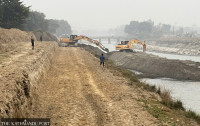National
Distributive nature of Constituency Development Fund in provinces set to continue
Authorities in Gandaki Province defend the provision, saying that the allocation would help complete small unfinished projects.
Prithvi Man Shrestha
Gandaki Province which received funds under the Constituency Development Programme for the first time this fiscal year has followed a familiar path—to use the allocated funds piecemeal in projects preferred by the lawmakers.
The programme, which was first introduced by the late finance minister Bharat Mohan Adhikari, in 1994, to please central-level lawmakers, has continued to date because of its distributive nature and due to potential of gross misuse of such funds for the projects aligned to political parties and leaders. The provincial governments also followed the same model after their establishment in 2017.
A regulation introduced by the provincial government has allowed allocating as low as Rs100,000 for a project. The regulation says if a small project needs to be selected, a maximum of three projects having the cost of Rs100,000 and a maximum of five projects having the cost of Rs200,000 can be selected. The regulation says maximum 25 projects can be selected in a constituency but two of them must have the cost of Rs2.5 million.
But, Ram Sharan Basnet, minister for Physical Infrastructure Development and spokesperson for the Gandaki government, defended the provision of the regulation allowing Rs100,000 in a project, saying that some small unfinished projects could be completed with this allocation.
“For example, some unfinished infrastructure can be completed with a small amount,” said Basnet. “We have had some buildings constructed from the funds. Similarly, some unfinished community buildings and some under-construction toilets can be completed with a small amount of money. The funds under this programme can be used in such projects.”
The budget for the current fiscal year to June 2020 has allocated Rs12 million for each provincial lawmaker in Gandaki Province under the Constituency Development Programme.
The regulation has also allowed lawmakers to implement the projects through the consumer committees without competition.
The regulation says the implementation can be done as per the existing laws and it does not bar the implementation of projects through the consumer committees. As per Public Procurement Law, projects having cost up to Rs10 million can be implemented through the consumer committees without a competitive tendering process.
Gandaki Province had not introduced the programme last fiscal year, but the provincial government was forced to introduce it due to pressure from the provincial lawmakers. When it introduced the regulation, it followed the federal government and other provinces that allow the fragmentation of limited resources.
Province 3 was another government which had not introduced the programme in the last fiscal year but heeded to provincial lawmakers this fiscal year. Other five provinces have continued the programme for this fiscal year as well, while increasing their budget under the programme. While many provinces are working towards revising the regulation, they have suggested that the distributive nature of the programme should continue.
Sudurpaschim Province is preparing to revise the regulation but is likely to continue its distributive provision, according to a provincial minister. The province, which had an allocated budget of Rs20 million for each of the lawmakers in the last fiscal year, increased the amount to Rs30 million for each lawmaker for the current year. There are 53 provincial lawmakers.
In the last fiscal year, the regulation had made provision that a maximum of 16 projects could be selected with at least one project having the cost of more than Rs3.5 million.
But, as the provincial government is working to revise the regulation, it wants to give a greater role to lawmakers elected through proportional representation instead of stopping the programme from being distributive.
Jhapat Bohora, minister of Economic Affairs and Planning, said that lawmakers do not want to invest the amount in a few large projects. “Their focus remains on smaller projects having the cost of Rs1.5 million to Rs2 million which have not been incorporated in the budget,” said Bohora. “They want to contribute to the construction of toilet and small drinking water projects.”
In Province 2, each lawmaker has been allocated Rs30 million under the Constituency Development Programme. The programme was distributed as the regulation allowed to select projects having cost of more than Rs500,000.
“We are now preparing to increase the threshold as we are revising the regulation,” said Bijaya Kumar Yadav, minister for Economic Affairs and Planning. “My opinion is that the threshold should be Rs2.5 million for each project.”
According to Yadav, the provincial assembly has also formed a committee to study and evaluate the outcome of the programme.
Karnali Province, meanwhile, has introduced a different type of programme focused on constituency development—one that goes under the headings of Infrastructure Special Programme and Janata Sadak Programme.
According to Prakash Jwala, minister for Economic Affairs and Planning, they are still working on a regulation on the implementation of Infrastructure Special Programme.
“We want to ensure that the budget is invested in large projects, as far as possible,” he said.
For the Janata Sadak Programme, the provincial government has allocated Rs50 million for each constituency for building its roads infrastructure.




 9.12°C Kathmandu
9.12°C Kathmandu















